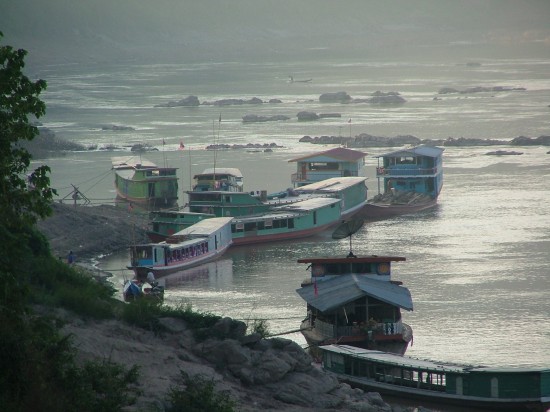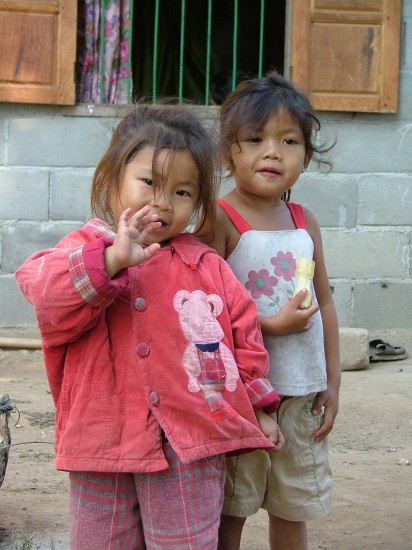In Part 1 of Journey into Laos, Vincent Ross began his journey on the mystic Mekong River. In Part 2, he explores a a sacred land once gripped by a secret war.
About 10,000 people live in Pakbeng and the surrounding area, with most working at the Udomkhaset sawmill and in the fledgling tourism industry.
In Laos, where up to 50 per cent of the government’s annual budget is foreign aid, and where some 85 per cent of its five million people are subsistence farmers, the morality of logging native forests is not a high political priority.
Pakbeng has a lively morning market where the locals gather to buy vegetables, everything from cauliflowers to parsley and green river slime, scattered in small piles on benches under which dogs sleep. The river slime, fried, salted and sprinkled with sesame seeds, actually tastes good.
Heading downriver in heavy morning fog, the captain deftly weaves the boat through endless bends skirted by rugged jungle peaks. Lone villagers crouch on the banks panning for gold, swirling the water in their bid to find specks of hope glinting in the rising sun.
A flash of colour against the green attracts the eye as an electric blue kingfisher darts into the shadows.
It was not so long ago that the jungle hid creatures far more dangerous.
In the ’60s, in the area north of Pakbeng, the infamous CIA operative Tony Poe fought in clandestine operations against the communists using an “army” of hill-tribe guerillas.
Poe paid bonuses for the ears of his enemies and is rumoured to have kept some of their heads pickled in formaldehyde in his hut.
Travelling on the Mekong today, it’s hard to imagine that 50 years ago, Laos was in the grip of a “secret war” against communist North Vietnamese and Pathet Lao troops, aimed at halting the march of communism in Indochina.
Actor Marlon Brando’s famous mumbled line in the 1979 Vietnam War epic Apocalypse Now — “The horror. The horror” — was very much a grim reality.
The nine-year war in Laos, which started in the mid-’60s, was guided from the West by CIA operatives and US Special Forces officers, who flew thousands of missions and trained and advised the Royal Lao Army and sympathetic Hmong hill-tribe guerillas.
Finned bomb casings used as planter pots for flowers can be seen in Luang Prabang, the legacy of an era which saw massive B52 air strikes on Laos.
Nearly two million metric tonnes of bombs were dropped on Laos, mainly on the Plain of Jars and along the Ho Chi Minh Trail, in a bid to rupture the communist supply line. Large tracts of jungle are still peppered with small, round cluster bombs, dangerous artefacts, some of which can be seen at the museum in the capital, Vientiane.
Around midday, the boat pulls in to another hamlet. Amid milling villagers who line the riverbank, lunch is bought — a half-a-dozen catfish.
Later, the boat stops at the temples of Tham Ting, the Caves of a Thousand Buddhas, opposite the village of Pak Ou, which literally means “mouth of the Ou River”, about 25km upstream from Luang Prabang.
The Buddhist shrine consists of two sacred grottoes honeycombed in sheer limestone cliffs. Karst peaks loom in the distance, seen in cut-out silhouette from the cool recesses of the main cave, where visitors are surrounded by Buddha statues of all shapes, sizes and poses.
Cave entry costs 8000 kip (about $C3), but includes the chance to pick a lucky stick, a small rolled sheet of predictions written in Thai, Lao and Chinese.
The Lao guide translated a rosy picture. “You will be an empire king. A good luck person and famous.”
As the sun lowered into the fading afternoon, the boat headed downstream, ploughing into a silver sheen of reflected light to cover the last kilometres to Luang Prabang.
An empire king? Hmmm.
What better portent to herald one’s arrival in the former royal capital of Laos, once known as Lan Xiang, “the land of a million elephants”?
Please bookmark Life As a Human and stay tuned tomorrow night at 9 pm PST for Part 3 of Vincent Ross’ “Journey into Laos”.
Photo Credits
“Laos: Lunag Prabang longboats on the Mekong at dusk” © Vincent Ross. All Rights Reserved.
“Laos: Mekong River woman husking grain Xieng Maen village” © Vincent Ross. All Rights Reserved.
“Laos Mekong River children in the village of Pakbeng” © Vincent Ross. All Rights Reserved.
“Laos Mekong River Xieng Maen village children” © Vincent Ross. All Rights Reserved.
“Laos: Mekong River Xieng Maen village boy” © Vincent Ross. All Rights Reserved.







[…] Part 2 of “Journey into Laos,” Vincent Ross discovered the people and spirit of the Mekong […]